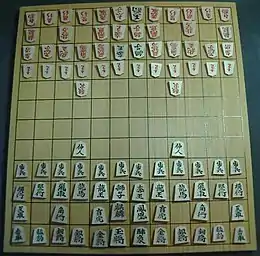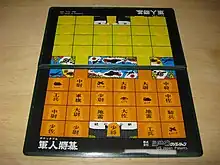
Gunjin Shōgi or Japanese Military Chess (軍人将棋), also known as Marching Chess (行軍将棋, Kōgun Shōgi), is a two-player board game, intended for children. Although the pentagonal pieces are shaped like those of Shōgi, the objective is to capture the other player's flag, more similar in gameplay to Stratego (1942) and its antecedent L'Attaque (1908). Both players start with an equal number of pieces in varying strengths; like Stratego and L'Attaque, Gunjin Shōgi is a game of imperfect information, where the placement of the opponent's pieces are hidden initially and must be determined by deduction. It is not known what influence these games, which were developed around the same time, may have had on each other, as there are notable similarities and differences.
History
Gunjin Shōgi has been sold and played since as early as 1895, although it is not known by whom and when it was invented.[1]: 129–130 Dr. Christian Junghans reported this game in Monatshefte magazine in Germany in 1905. It seems, only after reading his article, Julie Berg took out a patent on a war game in London and Paris in 1907.[2] Similarly, Hermance Edan took a patent for the game L'Attaque in 1909[3] and sold them in 1910;[1]: 154–158 Game historian Michel Boutin asserts Edan was influenced by Gunjin Shōgi;[4] however, papers left by Edan's estate indicate she had invented the game in the 1880s. L'Attaque in turn had a strong influence on Stratego, which was developed by Jacques Johan Mogendorff in the 1940s.[5]
There are multiple versions of Gunjin Shōgi, distinguished by the number of pieces controlled by each player as well as the size of the board. The 23- and 31-piece versions are similar, influenced by the technology of World War I, and the 25-piece version (aka Missile March, ミサイル行軍) is a more recent development, incorporating technologies developed during World War II.[6] Because most commercially available versions of Gunjin Shōgi show these more modern influences, the influence of the original design on L'Attaque, developed pre-WWI, is unclear.
Gunjin Shōgi is well-suited for video game implementation since the computer can take the place of the third-party arbiter without revealing the identity of pieces. Numerous examples exist, although many releases were limited to Japan.[7] A Simple series title was released as Ultimate Mind Games for PlayStation 2 for western markets, which included a Gunjin Shōgi implementation.[8]
Gameplay
| A | B | C | D | E | F | |
|---|---|---|---|---|---|---|
| 8 | ||||||
| 7 | ||||||
| 6 | ||||||
| 5 | ||||||
| — | ||||||
| 4 | ||||||
| 3 | ||||||
| 2 | ||||||
| 1 | ||||||
Gunjin Shōgi is characterized as a game for children because of its simple rules.[9]
- Basic gameplay and objective:
- Players take turns, moving one piece per turn.
- To win, a player must take the opponent's flag and occupy the opponent's headquarters. Only senior or flag officers may be used to occupy the headquarters.
- In some variations, occupying the headquarters is sufficient to win; in others, capturing all the opponent's mobile pieces or just the general can be a victory condition.
- The flag's strength depends on the adjacent piece immediately behind it.
- Initial setup:
- Each player's pieces are placed so their identities and starting positions are not visible to their opponent.
- Mines may not be placed at the entrances or exits to the bridges. For the 6×4 board shown as an example here, that means B4, B5, E4, and E5 may not contain mines.
- Placing the flag in the last row (closest to the player) means there is no piece that can be placed behind it as reinforcement, making it vulnerable to capture.
- Movement:
- Bridges are not considered a separate space, unless indicated on the board. For this 6×4 board example with "I" type bridges, that means that B4 and B5 are adjacent.
- Most human pieces move one space at a time: forward, backward, right, or left, but not diagonally.
- Engineers and, in some variants, also the spy, can move an unlimited number of empty spaces in a straight line (not diagonally).
- Mounted pieces (aerial and ground) are more mobile than most human pieces, with specific rules for movement depending on the variant. Typically, mounted ground units gain one bonus move forward, and aerial units can move forward and backward and jump over occupied spaces.
- The atomic bomb is stationary unless adjacent to a missile, which can "carry" it.
- Attack:
- Two opposing pieces adjacent to each other (not diagonally) may attack. In this example, if it is the orange player's turn, the Lieutenant at B4 could attack the piece at B5, or the Captain at E4 could attack the piece at E5.
- Pieces with higher strength win the attack and remain on the board. A third-party observer usually is used to judge the results from the attack.
- The spy is the only piece that can defeat the general. Conversely, the spy is defeated by every other piece.
- Mines defeat all attackers except the engineer. Regardless of the attacker, after a mine is attacked it is removed from the board.
- Missiles remove pieces from five spaces (the space where it lands plus the spaces immediately forward, backward, left, and right) unless a "mid-air collision" has occurred, which is when one of those five spaces is occupied by an opponent's missile. In that case, only the two missiles are removed from the board.
- When the missile is carrying an atomic bomb, the pieces in nine spaces are removed (adding diagonal directions). Again, a "mid-air collision" cancels this, resulting in the removal of both missiles and the atomic bomb.
Since its release, publishers have created many versions of Gunjin Shōgi, which have differing rules, piece counts, and gameboard sizes. All versions have several common features, including a hierarchy of strengths based on military officer ranks, mines and engineers to defuse them, a weak spy able to capture the most powerful general, a headquarters area, and a flag or other stationary object to be captured; despite these, there is a wide variety of mechanized and mounted units (planes, tanks, cavalry, infantry, missiles, atomic bombs) and gameboard layouts.
Pieces Name |
Strength | 23[10] | 25[6] | 31[11] | Notes | |
|---|---|---|---|---|---|---|
| Board size (home area) | 6×4 | 9×3 | 8×4 | Typically has "bridges" over a river, represented by the center of the board, with either straight, X, or Y shapes. Bridges are not counted as a separate row: the squares connected by the bridges are considered to be adjacent to each other. Military headquarters occupy the 2 or 3 squares in the center of the row closest to each player. | ||
| Human pieces | ||||||
| Flag officers | ||||||
| General 大将 |
14 | 1 | 1 | 1 | The flag officers can move one adjacent space forward, backward, left, or right. | |
| Lieutenant General 中将 |
13 | 1 | 1 | 1 | ||
| Major General 少将 |
12 | 1 | 1 | 2 | ||
| Senior officers | ||||||
| Colonel 大佐 |
9 | 1 | 2 | 2 | The senior officers can move one adjacent space forward, backward, left, or right. | |
| Lieutenant Colonel 中佐 |
8 | 1 | 2 | 2 | ||
| Major 少佐 |
7 | 1 | 2 | 2 | ||
| Junior officers | ||||||
| Captain 大尉 |
6 | 2 | 0 | 2 | The junior officers can move one adjacent space forward, backward, left, or right. | |
| Lieutenant 中尉 |
5 | 2 | 0 | 2 | ||
| 2nd Lieutenant 少尉 |
4 | 2 | 0 | 2 | ||
| Specialists | ||||||
| Engineer 工兵 |
2 | 2 | 3 | 3 | Engineers can move like a rook in chess, over any number of empty squares forward, backwards, left, or right, similar to the scout in L'Attaque and Stratego. They cannot jump over occupied squares. | |
| Spy スパイ |
1 | 1 | 1 | 1 | The spy can only beat the general. For the 25-piece game, the spy follows the same movement rules as the engineers; for the other games, the spy follows the same one-square movement rules as the general and field officers. | |
| Mounted pieces | ||||||
| Aerial | ||||||
| Plane 飛行機 |
11 | 2 | 0 | 2 | The plane can move forward or backward any number of squares, or move left or right one square. It can jump over other pieces. Planes beat all pieces except flag officers (generals, lieutenant generals, and major generals). | |
| Jet ジェット機 |
0 | 2 | 0 | In the 25-piece game, the jet can move to any square except to squares occupied by friendly pieces or the opponent's marshal. | ||
| Missile ミサイル |
— | 0 | 2 | 0 | Movement is similar to the jet, unrestricted except to squares occupied by friendly pieces or the opponent's marshal. By itself, the missile removes all pieces in the four adjacent squares (forwards, backwards, left, and right) from where it fell, unless one of those squares is occupied by an opponent's missile, in which case only the two missiles are removed. | |
| Ground | ||||||
| Tank タンク |
10 | 2 | 2 | 3 | Tanks follow the same movement rules as Cavalry for the 23- and 31-piece games; for the 25-piece game, they follow the same movement rules as Engineers. Tanks beat all pieces except generals, planes, engineers, and mines. | |
| Cavalry 騎兵 |
3 | 1 | 0 | 2 | Cavalry can move forward two squares in a single turn, or use regular movement rules (one adjacent square). These pieces cannot jump other pieces when moving forward two squares. Cavalry only beat spies and engineers. | |
| Artillery 砲兵 |
0 | 2 | 0 | Artillery follows the same movement rules as the Engineers. | ||
| Stationary pieces | ||||||
| Attack / Defense | ||||||
| Mine 地雷 |
— | 2 | 2 | 3 | Mines are a single-use item; they are removed after being attacked, along with the attacking piece unless attacked by an engineer. Mines may not be placed at the entrances or exits to bridges. In the 8×6 example board shown, mines cannot be placed at B5, E5, B4, or E4. | |
| Atomic bomb 原爆 |
— | 0 | 1 | 0 | Immobile unless adjacent to a missile, in which case the pieces can be moved together. When the missile enters the opponent's camp, all pieces in the eight adjacent squares (forwards, backwards, left, right, and diagonally) from the bomb's square are removed, unless one of those squares is occupied by an opponent's missile, in which case only the two missiles and the atomic bomb are removed. | |
| Leaders | ||||||
| Flag 軍旗 |
varies | 1 | 0 | 1 | The flag's strength is determined by the piece behind it. | |
| Marshal 元帥 |
— | 0 | 1 | 0 | The marshal is immobile and takes the place of the flag for the 25-piece game. Vulnerable to attack only by a flag or senior officer, and only when there are no adjacent friendly pieces. | |
Boards
Hironori Takahashi has documented at least a dozen varieties of game boards; the size and configuration of the player's "home area", where they deploy their pieces, are tied to the total number of pieces per player.[1]: 107–108
| Pieces per player | Deployment area for each player | ||
|---|---|---|---|
| Columns | Rows | Headquarters | |
| 35 | 7 | 5 | 1×1 |
| 31 | 8 | 4 | 2×1 |
| 28 | 7 | ? | |
| 26 | 3×1 | ||
| 25 | 5 | 5 | 1×1 |
| 25 | 9 | 3 | 3×1 |
| 23 | 6 | 4 | 2×1 |
| 22 | 7 | 3 | +2×1 |
| 21 | 1×1 | ||
| 17 | 9 | 2×1 | |
| 15 | 5 | 1×1 | |
| 10 | 5 | 1×1 | |
Each game board also features "bridges" connecting the two player deployment areas. The bridges are either straight ("I"), crossed ("X"), or branching ("Y") types, arranged symmetrically from left to right. Some of the X-type bridges have a circular spot in the middle, so a player will enter the bridge on one turn from either one of the two legs, occupying the middle, then on the next turn exit at either one of the two exits.[1]: 108
- Diagrams of Gunjin Shōgi boards
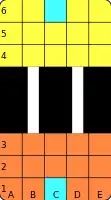 Two player areas each 5×3, connected by two "I" bridges spanning B3-B4 and D3-D4.
Two player areas each 5×3, connected by two "I" bridges spanning B3-B4 and D3-D4. 5×5 player areas, two "I" bridges
5×5 player areas, two "I" bridges![6×4 player areas, two "I" bridges [23-piece game]](../I/Gunjin_Shogi_6x4%252B2i.svg.png.webp) 6×4 player areas, two "I" bridges [23-piece game]
6×4 player areas, two "I" bridges [23-piece game]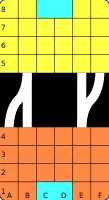 6×4 player areas, two "Y" bridges. A player entering the left bridge at B5 may move to either A4 or B4.
6×4 player areas, two "Y" bridges. A player entering the left bridge at B5 may move to either A4 or B4.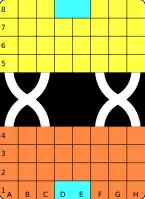 8×4 player areas, two "X" bridges. A player entering the right bridge at F4 may travel to F5 or H5, but not H4.
8×4 player areas, two "X" bridges. A player entering the right bridge at F4 may travel to F5 or H5, but not H4.![8×4 player areas, two "X" bridges with center spots [31-piece game]](../I/Gunjin_Shogi_8x4%252B2oX.svg.png.webp) 8×4 player areas, two "X" bridges with center spots [31-piece game]
8×4 player areas, two "X" bridges with center spots [31-piece game]![9×3 player areas, two "X" bridges [25-piece game]](../I/Gunjin_Shogi_9x3%252B2X.svg.png.webp) 9×3 player areas, two "X" bridges [25-piece game]
9×3 player areas, two "X" bridges [25-piece game]
Pieces
Gunjin Shōgi pieces were made from wood until the late 1980s, when manufacturing was switched over to plastic. It is possible to memorize the grain patterns on the back of the wooden pieces, which makes it difficult to conceal the opponent's initial setup.[12]
(D)efender (A)ttacker |
General | Lt General | Mine | Major General | Plane | Tank | Col | Lt Col | Major | Captain | Lieut | 2nd Lt | Cavalry | Engineer | Spy |
|---|---|---|---|---|---|---|---|---|---|---|---|---|---|---|---|
| General | AD | A | AD | A | A | A | A | A | A | A | A | A | A | A | D |
| Lt General | D | AD | AD | A | A | A | A | A | A | A | A | A | A | A | A |
| Mine | — | — | — | — | — | — | — | — | — | — | — | — | — | — | — |
| Major General | D | D | AD | AD | A | A | A | A | A | A | A | A | A | A | A |
| Plane | D | D | A | D | AD | A | A | A | A | A | A | A | A | A | A |
| Tank | D | D | AD | D | D | AD | A | A | A | A | A | A | A | A | A |
| Colonel | D | D | AD | D | D | D | AD | A | A | A | A | A | A | A | A |
| Lt Colonel | D | D | AD | D | D | D | D | AD | A | A | A | A | A | A | A |
| Major | D | D | AD | D | D | D | D | D | AD | A | A | A | A | A | A |
| Captain | D | D | AD | D | D | D | D | D | D | AD | A | A | A | A | A |
| Lieut | D | D | AD | D | D | D | D | D | D | D | AD | A | A | A | A |
| 2nd Lt | D | D | AD | D | D | D | D | D | D | D | D | AD | A | A | A |
| Cavalry | D | D | AD | D | D | D | D | D | D | D | D | D | AD | A | A |
| Engineer | D | D | A | D | D | D | D | D | D | D | D | D | D | AD | A |
| Spy | A | D | AD | D | D | D | D | D | D | D | D | D | D | D | D |
(D)efender (A)ttacker |
Missile | Atomic Bomb | General | Lieutenant General | Major General | Jet | Tank | Colonel | Lieutenant Colonel | Major | Mine | Artillery | Engineer | Spy | Marshal |
|---|---|---|---|---|---|---|---|---|---|---|---|---|---|---|---|
| Missile | AD | A | A | A | A | A | A | A | A | A | AD | A | A | A | — |
| Atomic bomb | — | AD | A | A | A | A | A | A | A | A | AD | A | A | A | — |
| General | D | D | AD | A | A | A | A | A | A | A | AD | A | A | D | X |
| Lieutenant General | D | D | D | AD | A | A | A | A | A | A | AD | A | A | A | X |
| Major General | D | D | D | D | AD | A | A | A | A | A | AD | A | A | A | X |
| Jet | D | D | D | D | D | AD | D | A | A | A | AD | D | A | A | — |
| Tank | D | D | D | D | D | D | AD | A | A | A | AD | D | D | A | D |
| Colonel | D | D | D | D | D | D | D | AD | A | A | AD | A | A | A | X |
| Lieutenant Colonel | D | D | D | D | D | D | D | D | AD | A | AD | A | A | A | X |
| Major | D | D | D | D | D | D | D | D | D | AD | AD | A | A | A | X |
| Mine | — | — | — | — | — | — | — | — | — | — | — | — | — | — | — |
| Artillery | D | D | D | D | D | A | A | D | D | D | A | AD | A | A | D |
| Engineer | D | D | D | D | D | D | A | D | D | D | A | D | AD | A | D |
| Spy | D | D | A | D | D | D | D | D | D | D | AD | D | D | D | D |
| Marshal | — | — | — | — | — | — | — | — | — | — | — | — | — | — | — |
- Notes
- A = Attacker wins, defender removed from board
- D = Defender wins, attacker removed from board
- AD = Both attacker and defender removed from board
- X = Defender wins if there are still friendly pieces present, otherwise loses
Differences with Stratego
The main differences between Gunjin Shōgi and Stratego are:
- Gunjin Shōgi needs a referee to resolve the battles of the pieces, which are kept face-down throughout the game.[6]
- The Flag is placed only on the headquarters and a player who successfully occupied the headquarters of the opponent shall win the game.
- There are no Scout pieces. The Engineers and Spy have the same movement as the Scouts in Stratego.
- Only flag and senior officers can occupy the opponent's headquarters.
- Engineer (analog of miner) can remove mines and tanks.
References
- 1 2 3 4 Takahashi, Hironori (2016). "Military Chess in Japan and the World". The Institute of Amusement Industry Studies Osaka University of Commerce No. 18. JPN.
- ↑ FR Patent 379625A, Julie Berg, "Jeu de la guerre", published November 13, 1907
- ↑ FR patent 396795, Hermance Edan, "Jeu de bataille ave pièces mobiles sur damier", published 20 April 1909
- ↑ Boutin, Michel (December 2013). "L'Attaque, un jeu français issu du Gunjin Shogi". In Van Langendonckt, Michel (ed.). Art et savoir de L'Inde. Jeux indiens et originaires d'Inde. Vol. 2. Brussels. pp. 233–268. ISBN 978-2-9601719-1-4. OCLC 967714966.
- ↑ Depaulis, Thierry. "The History of Stratego | UltraBoardGames". www.ultraboardgames.com. Retrieved 2020-02-05.
- 1 2 3 "日本軍人将棋連盟ホームページにようこそ" [Welcome to the website of the Japan Military Shōgi Federation]. tanken.com (in Japanese). Retrieved 18 July 2023.
駒や盤の取り方などは時代によって(あるいは製造元によって)多少異なるようです。第1次大戦後にはタンクや地雷が、第2次大戦後には毒ガスや飛行機、原爆が登場するなど、現実の戦争に応じて、次々と進化を遂げてきました。[Pieces and boards differ slightly depending on when or who manufactured them. After World War I, tanks and mines were included, and after World War II, poison gas, airplanes, and atomic bombs were added.]
- ↑ "帰って来た!軍人将棋,なんやそれ!?" [I'm back! Military shogi, what is that!?] (in Japanese). Retrieved 24 July 2023.
- ↑ "Ultimate Mind Games". Moby Games. Retrieved 24 July 2023.
- ↑ "改訂版ミサイル行軍・解説" [Commentary for 'Revised Missile March'] (in Japanese). Retrieved 21 July 2023.
- 1 2 "軍人将棋の紹介〔ルール解説含む〕" [Introduction to military shōgi (including rules)]. chushogi-renmei.com (in Japanese). December 17, 2000. Retrieved 18 July 2023.
- ↑ 澤田真一 (11 August 2019). "軍人将棋とは?ルールと遊び方・魅力を紹介。AIに勝てなくなってきた今こそやってみたい!" [What is Military Shōgi ? Introducing rules, gameplay, and strategy. I want to try it now that I can't beat AI Shōgi!]. Into Japan Waraku (in Japanese). Retrieved 20 July 2023.
- ↑ "軍人将棋" [Military Shōgi]. Shōgi Pen Clublog (in Japanese). November 29, 2009. Retrieved 20 July 2023.
- ↑ "ミサイル行軍" [Missile March]. pmctomo.fanblogs (in Japanese). June 1, 2018. Retrieved 21 July 2023.
External links
- Gunjin Shogi at BoardGameGeek
- 軍人将棋(行軍将棋) on YouTube: screen recording of a computer match, using the 23-piece variant
